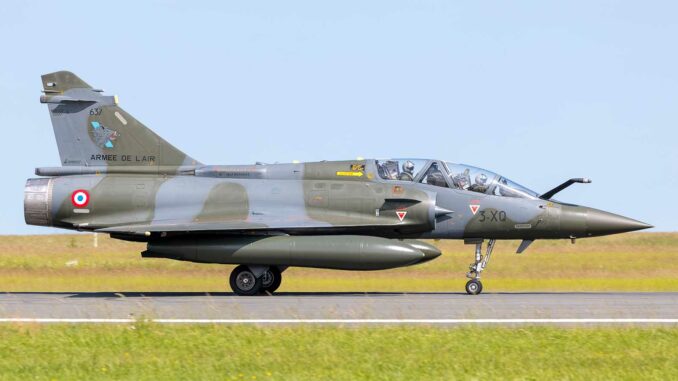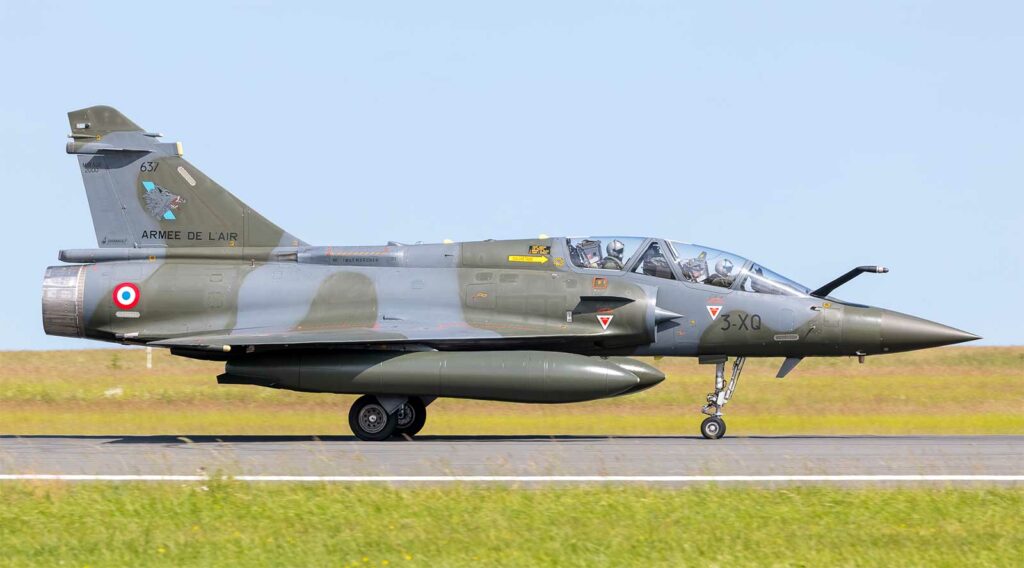
On the night of 16 to 17 October, two Mirage 2000s broke Mach 1 to intercept a non-responsive aircraft. Documented account, procedures, figures and issues.
Summary
On the night of 16-17 October, the air police launched an air interception over France after losing radio contact with a civilian aircraft. Two Mirage 2000s were authorised to exceed Mach 1 (approximately 1,225 km/h at sea level), causing a sonic boom heard from Seine-et-Marne to Yonne, and as far as Loiret. The measure is part of the permanent French air defence posture, led by the CDAOA, which can impose supersonic flight when safety takes precedence over noise pollution. The event was not an exercise. It illustrates the need for a rapid response to uncooperative traffic in sensitive airspace. French rules strictly regulate supersonic speed over land, but exemptions are possible in emergencies. Beyond the noise and vibrating windows, the episode serves as a reminder of the fundamentals: civil-military coordination, the doctrine of use of Mirage 2000 aircraft, and public education to explain these alerts.
The facts of the night: a real alert, not an exercise
Between 11 p.m. and 11:30 p.m. on the night of Thursday 16 to Friday 17 October, many municipalities in the eastern Paris Basin reported a loud explosion, with vibrations on building facades and calls to the emergency services. Local headlines mentioned ‘explosions’ felt from eastern Loiret to neighbouring departments, notably Yonne and Seine-et-Marne. These noises corresponded to a supersonic bang caused by fighter jets exceeding Mach 1 to catch up with a non-responsive civilian aircraft. Initial reports from the press and local authorities concur: the event was the result of an actual interception mission authorised on the night of 16 to 17 October, unrelated to any scheduled training exercise.
The ‘air police’ posture: who decides and how
Surveillance of national airspace is the responsibility of the CDAOA, which maintains a permanent security posture. Detection centres track flight paths, correlate flight plans and trigger a scramble if an aircraft becomes uncooperative: transponder switched off, inconsistent route, loss of voice contact, or approach to a sensitive area. Fighters assigned to operational readiness (PO) are generally ready within minutes. Once in the air, the defence authority may lift the supersonic restriction for air safety reasons in order to reduce interception time. This capability has already been used in the past over the Île-de-France region during real alerts.
The role of the Mirage 2000: an interceptor designed for emergencies
The Mirage 2000 is a single-engine delta-wing fighter capable of reaching Mach 2 at altitude and rapid acceleration beyond Mach 1 for interceptions. In the modernised 2000-5 and 2000C/D versions, the aircraft combines multi-mode radar, data links and air-to-air missiles (including MICA), adapted to the mission of policing the skies while remaining within the framework of graduated rules of engagement. Its climb rate and ability to reach supersonic speeds in level flight make it a useful tool for quickly ‘reconnecting’ with a civilian aircraft that is no longer responding.
The sonic boom: a predictable physical phenomenon
The sonic boom comes from the shock wave generated when the aircraft exceeds the speed of sound (≈ 340 m/s, or ≈ 1,225 km/h at sea level). This wave propagates to the ground in the form of a ‘Mach cone’ and can be heard over several tens of kilometres. Its intensity depends on the altitude, mass, speed and trajectory of the aircraft: the lower and faster it is, the more the ‘boom’ is felt. Reports of windows shaking in eastern Île-de-France and northern Burgundy are therefore consistent with an emergency authorised Mach 1+ flight.
French rules on supersonic flight: prohibitions and exemptions
In France, supersonic flights over land are in principle prohibited, except in dedicated training areas or over the sea, precisely to avoid noise pollution. The Military Air Traffic Regulations (RCAM) strictly regulate these cases: profiles, altitudes, distances, exclusion zones. In air safety situations, the authority may grant a one-off, tracked exemption, giving time to secure the intercepted aircraft and remove any doubt. It is this framework that allows Mirage 2000s to exceed Mach 1, even at night, when time is more important than noise pollution.
The interception chain: from civil radar to visual confirmation
A typical alert often starts with civil air traffic control, which detects the loss of radio contact and alerts the CNOA. The CDAOA then triggers the PO. On approach, the fighters establish radar contact, assess the separation from third-party traffic and reach the target in accordance with air safety instructions. This is followed by standard interception manoeuvres (visual, waggle wings, turning on lights, presenting transponder code) to re-establish communication or convey simple orders: follow, turn, align with a prescribed route. As a last resort, if the aircraft remains unresponsive and poses a risk, the authority may impose a diversion to an identified airfield. Similar cases have been documented by the French and European authorities over the years.
Ground signals: calls, FR-Alert and education
During a supersonic bang, emergency numbers record a spike in calls reporting ‘explosions’ or ‘earthquakes’. Prefectures or town halls sometimes publish reassuring messages after the event. The night of 16 to 17 October was no exception: several local authorities and media outlets reported the detonation and vibrations; some explicitly linked the phenomenon to military aircraft breaking the sound barrier in an interception context. This ‘after the fact’ communication remains essential to avoid rumours and explain the logic of French air defence.

The operational reasons for Mach 1 at night
Why allow supersonic flight at night? Because time is the critical variable when an aircraft approaches sensitive airspace without responding. At Mach 0.9 (approximately 1,100 km/h at sea level), it could sometimes take several minutes longer to reach the target; above Mach 1, this delay is drastically reduced over distances of around 100 to 200 km. Responsiveness provides protection: it allows the pilot’s condition to be checked (hypoxia, radio failure), malicious intent to be ruled out, and intrusion into a restricted area (strategic sites, dense approach corridors) to be avoided. Previous incidents in the Paris region show that these authorisations exist and are used on an ad hoc basis when the risk assessment justifies it.
Impacts and proportionality: nuisance vs. safety
A supersonic bang is not insignificant: it can startle people, wake them up, and cause windows to rattle. But the principle of proportionality applies: occasional noise pollution is preferable to an uncontrolled airborne risk. The RCAM requires minimising the ground footprint by favouring altitude, the least dense trajectories and the shortest possible exposure time. Feedback from the field on 16-17 October describes a single night-time ‘boom’, consistent with acceleration limited to the catch-up phase.
Lessons learned: coordination, radio discipline and transparency
Three lessons stand out. First, civil-military coordination works: detection, decision-making, interception and feedback all took place within minutes. Second, radio discipline on the general aviation and transport side remains crucial: a simple voice failure or incorrect transponder setting can trigger a scramble, with avoidable operational costs and nuisance. Finally, local transparency (prefectures, town halls, media) reduces anxiety and cuts short speculation; previous episodes show that providing information quickly after a supersonic bang has become good practice.
Key figures to remember
– Speed of sound: ≈ 340 m/s (≈ 1,225 km/h) at sea level.
– Typical audibility zone: several tens of kilometres depending on altitude and trajectory.
– Time frame: 11 p.m.–11:30 p.m. (Thursday, 16 October) for the peak of reports in eastern Loiret, Yonne and Seine-et-Marne.
– Regulatory framework: general ban on supersonic flights over land, exemptions possible in the event of a safety emergency.
This episode serves as a reminder that French air defence is designed to act quickly, day or night. The next useful steps are not spectacular: internal feedback, public education, and reminding civilian pilots of best practices (radio checks, emergency voice communication, transponder codes). The aim is not to avoid all supersonic booms — that would be unrealistic — but to reserve this manoeuvre for its intended purpose: to gain the minutes that prevent an incident from becoming a crisis.
War Wings Daily is an independant magazine.